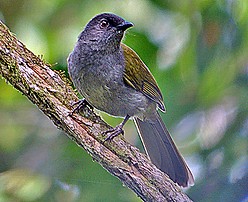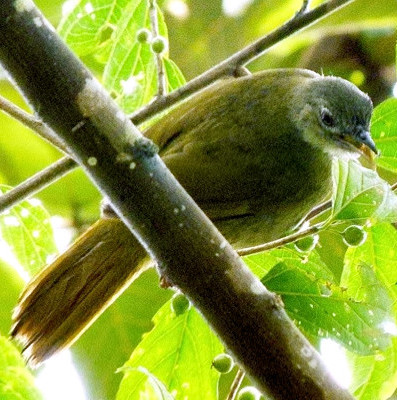
Pycnonotus masukuensis
TAXONOMY
Pycnonotus masukuensis Shelley, 1897, Masuku Range, east-central
Africa. Species level taxonomy unclear. Two groups of subspecies
recognized: gray-headed western group and greenheaded
nominate group.
OTHER COMMON NAMES
English: Shelley’s bulbul; French: Bulbul des Monts Masukus;
German: Shelleybьlbьl; Spanish: Bulbul de Shelley.
PHYSICAL CHARACTERISTICS
6.3 in (16 cm); 0.9–1.1 oz (27–31 g). Bright green upperparts,
underparts dull olive. Head and neck variable; gray, olive-gray,
or olive. Pale eye-ring. Sexes alike. Juvenile resembles adult,
but olive parts deeper colored, upperparts duller.
DISTRIBUTION
Endemic resident of middle elevation highlands in east-central
Africa. Eastern Zaire to Uganda, Rwanda, western Kenya, eastern
Tanzania into Malawi.
HABITAT
Montane rainforest, riverside scrub.
BEHAVIOR
Typically found singly or in pairs, may forage in larger groups.
Unusually silent for a bulbul, has soft song of “chip, wa-da-tee,
chee-tu, ti-wew.” Nonmigratory.
FEEDING ECOLOGY AND DIET
Eats berries and insects. Often uses “treecreeper” foraging
method, whereby it starts at the base of a tree looking for insects,
works its way up the tree in short hops for 18–30 ft
(6–10 m), then flies to base of next tree and starts again.
REPRODUCTIVE BIOLOGY
Not well known. Nest a strong, shallow cup; lays one or two
pinkish, spotted eggs.
CONSERVATION STATUS
Not threatened. Fairly common to locally abundant.
SIGNIFICANCE TO HUMANS
None known.
Photo Gallery of - Shelley’s greenbul




 Animalia Life
Animalia Life